WASHINGTON, D. C. – A fungus that attacks the leaves of coffee trees threatens to devastate Guatemala’s coffee industry, but the head of an association that represents Guatemalan coffee growers says his government needs to wake up and smell the reality. “During 2014, the rust affected 65 to 70 percent of our total cultivated area,” said Miguel Medina, president of Guatemala’s National Coffee Association (Anacafé), speaking to us Friday from Anacafé’s headquarters in Guatemala City. “Even though it was severe, we can say that most of it was between levels two and three on a scale of one to four, while in 2013, it was between levels three and four.
Medina said Anacafé’s goal is to maintain coffee rust – known in Spanish as roya – between levels one and two, “which is what we call the preventive state of rust, and control it without any economic damage to coffee production.” To do that, Anacafé has purchased 30,000 liters of fungicide in each of the past two years, at a cost of $2.5 million annually, in order to give producers the lowest prices possible. That was enough to cover 80,000 hectares, which is only one-third of the acreage now affected by coffee rust. In total, he said the organization has spent about $15 million to control roya.
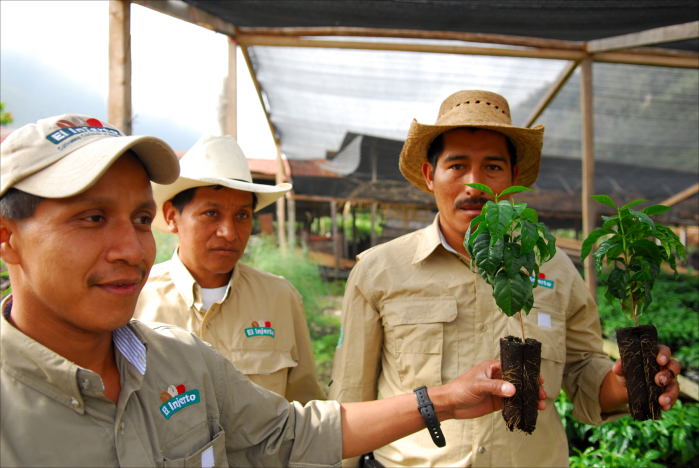
But that’s clearly not enough if Guatemala has any hopes of making a dent in the disease’s rapid spread throughout the country. Iliana Martínez manages the Esquipulas coffee cooperative from her storefront office along the main street of La Libertad, a town in the department of Huehuetenango, 510 kilometers (317 miles) from Guatemala City. Founded in 1964, the association now has 945 members, up from 680 members in 2012 and 380 back in 2007.
“In the last harvest, our production was down by 20 percent here at our co-op,” Martínez said, estimating that the fight against roya has forced up production costs for her members by at least 20 percent. “It is very difficult to face this crisis because we get no subsidies or government support to at least help alleviate this situation.”
Anacafé says the extent to which coffee can recover depends largely on the ability of co-ops like Esquipulas to get proper financing. But that effort has itself become mired in controversy.
Medina said the government last year approved a funding mechanism that was aimed at injecting $100 million into the Guatemalan coffee sector. Of that total, $52 million was in the form of loans at interest rates of between 8 and 11 percent.
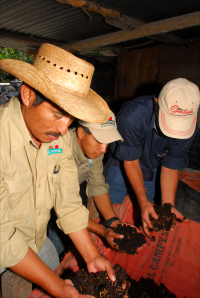
However, he said, “People weren’t taking advantage of the program because the rates were too high, and because it was supposed to finish in 2016. Nobody in the coffee sector is going to take out a high-interest loan that you have to pay back in two or three years.”
Related: Climate change is making coffee a risky bet for Central America
Following intervention from Anacafé, the program was extended to 2026 and interest rates were slashed to 2 percent for small producers and 3 percent for medium and large-scale producers. But in the meantime, the government had allocated the remaining $48 million in the kitty to pay for roads and other infrastructure.
“They used the money that was supposed to fund the coffee sector. Banks have authorized loans for $32 million and coffee producers are waiting to invest in their plantations, but the government is now offering them only Q10 million (about $1.5 million),” Medina said. “This makes a mockery of the coffee business.”
Anacafé, a nonprofit group, has 125,000 members and assesses a 1 percent tax on the FOB price of all coffee exported from Guatemala – an arrangement that generates $6 million to $10 million a year. In return, it offers its members promotion and technical assistance, as well as a sophisticated soil and leaf analysis lab.
Last summer, Starbucks and Green Mountain – two major U.S. buyers of Guatemala’s prized arabica coffee – teamed up with the U.S. Agency for International Development, reported NPR.com. Together they have pooled more than $23 million to offer financing to repair crops and fight the scourge.
“Rust is something that can be prevented, but it cannot be totally eradicated,” said Medina. “We have an alert system that we’ve been developing through two methods: meteorological stations all over the country, and technicians constantly monitoring the severity of rust in farms, as well as weather, temperature, rain and relative humidity. That way, we can decide if we think a certain area needs to be sprayed with fungicide sooner than we were recommending.”
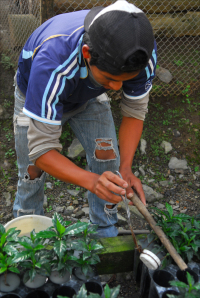
Medina, whose family has been in the coffee business since 1883, has headed Anacafé since mid-November. Before that, he was vice president for two years, and was on Anacafé’s board of directors for two years before that.
“The way I see it, people need access to medicine, health and education, which in these times have become luxuries,” he said. “But they still need to eat. So they have two options: leave the country and go to the U.S., or stay here and maybe become part of the crime scene.”
Related: Guatemalan coffee exporters hope 2015 will bring better news
Medina said Guatemala’s export of 4.8 million quintales (100 pounds) of coffee beans in the 2012-13 crop required 73 million labor-days, or roughly half a million jobs. When the crop shrunk to 4.08 million quintales in 2013-14, the industry lost 10.3 million labor-days, or about 70,000 jobs.
That, he said, translates into $120 million that wasn’t paid in wages. “Not only were those days not used, it means that money did not circulate in rural areas. This is hurting not only people who work directly in coffee, but those who indirectly live from the industry as well,” he said, noting that coffee is Guatemala’s biggest employer, providing jobs for 1.1 million people or 18 percent of the country’s active working population.
On Jan. 1, Guatemalan President Otto Pérez Molina authorized a 5 percent increase in the national minimum wage. Since 70 percent of the cost of coffee is labor, said Medina, that automatically pushes costs up by 3.5 percent.
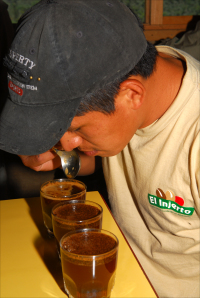
Medina said Guatemala and neighboring Honduras have controlled coffee rust considerably better than Central America’s two other top coffee producers, El Salvador and Costa Rica. In El Salvador’s case, production fell from 1.9 million sacks in 2010-11 to 500,000 bags in 2013-14. Likewise, Costa Rican production plummeted from 1.38 million sacks in 2011-12 to roughly 500,000 bags in 2013-14.
Last June, Medina’s association unveiled a new variety, Anacafé-14, which is a hybrid between the Pacamara and Catimor plants.
“It’s very productive, rust-resistant and has a big cup quality, so we’re recommending planting it in the places where rust is most likely to appear and at lower altitudes,” he said. However, Medina does not suggest planting such varieties at altitudes exceeding 1,200 meters (4,000 feet). The Anacafé chief is also wary of engaging in widespread planting of cultivars that are resistant to rust, such as Caturra or Castillo, the latter being the clear favorite in Colombia.
“In 11 years, we haven’t had one single Castillo win the Cup of Excellence award,” he said. “They aren’t horrible, but when you compare it to other coffees in the same place, normally the non-rust resistant varieties will grade higher.”
He added: “Rust-resistant varieties are more prone to be attacked by another fungus. I think it’s very risky to tell everyone to plant one single variety.”
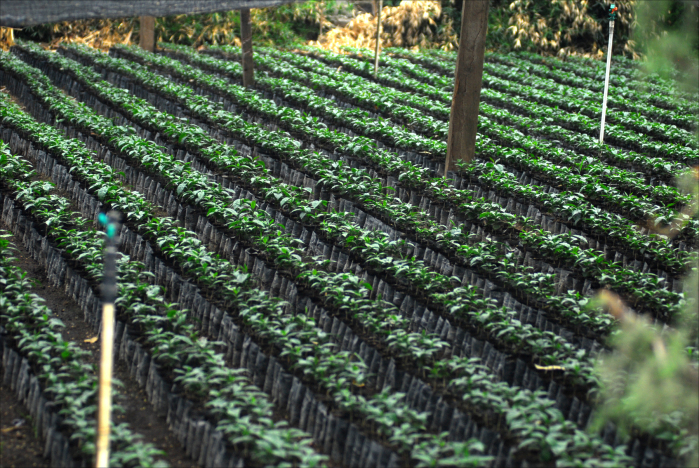
See also: 5 things you might not know about the science of coffee
See also: The $6 cup of coffee comes to Costa Rica (and that’s a good thing)






